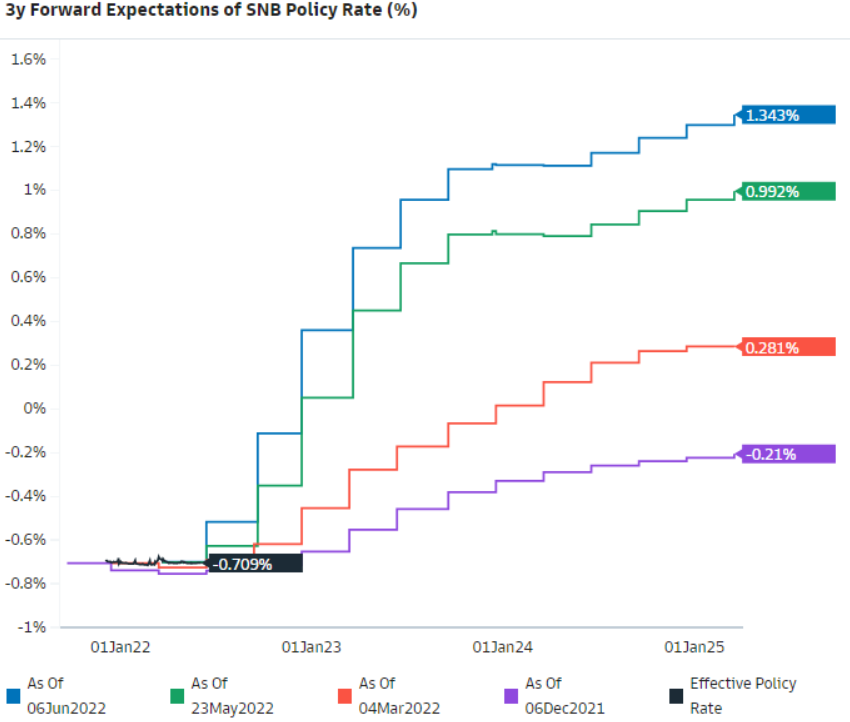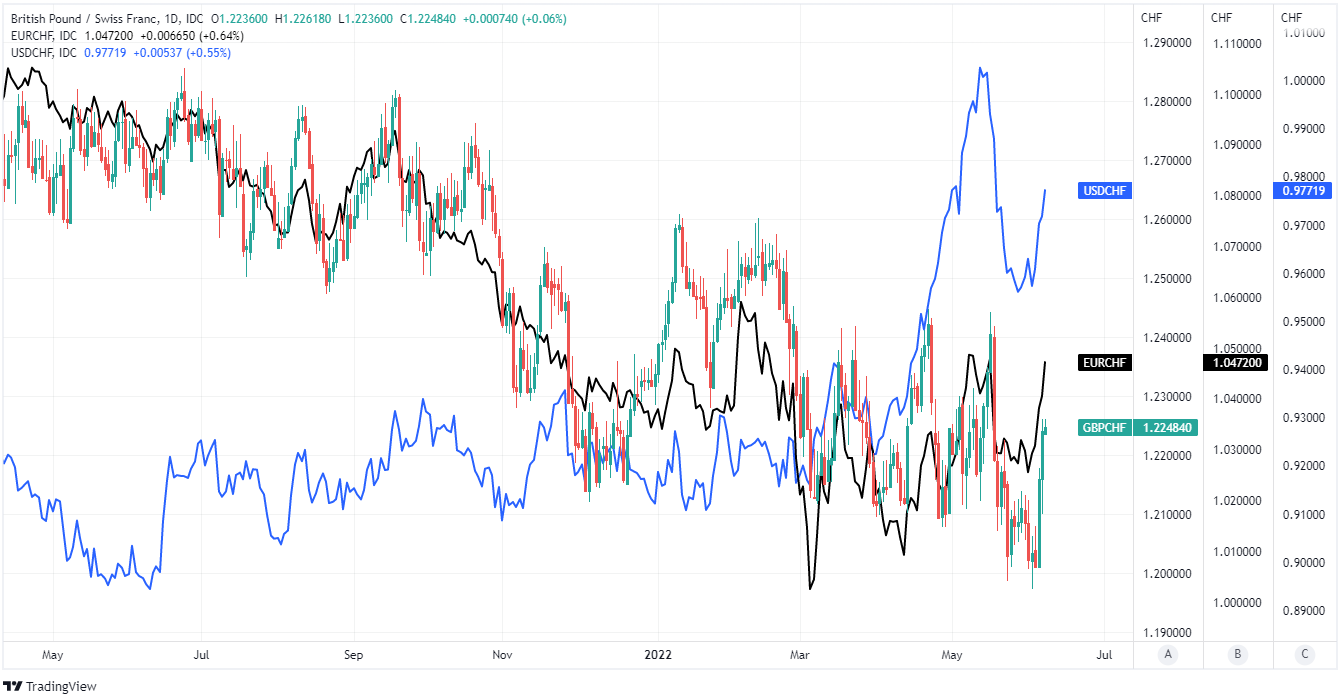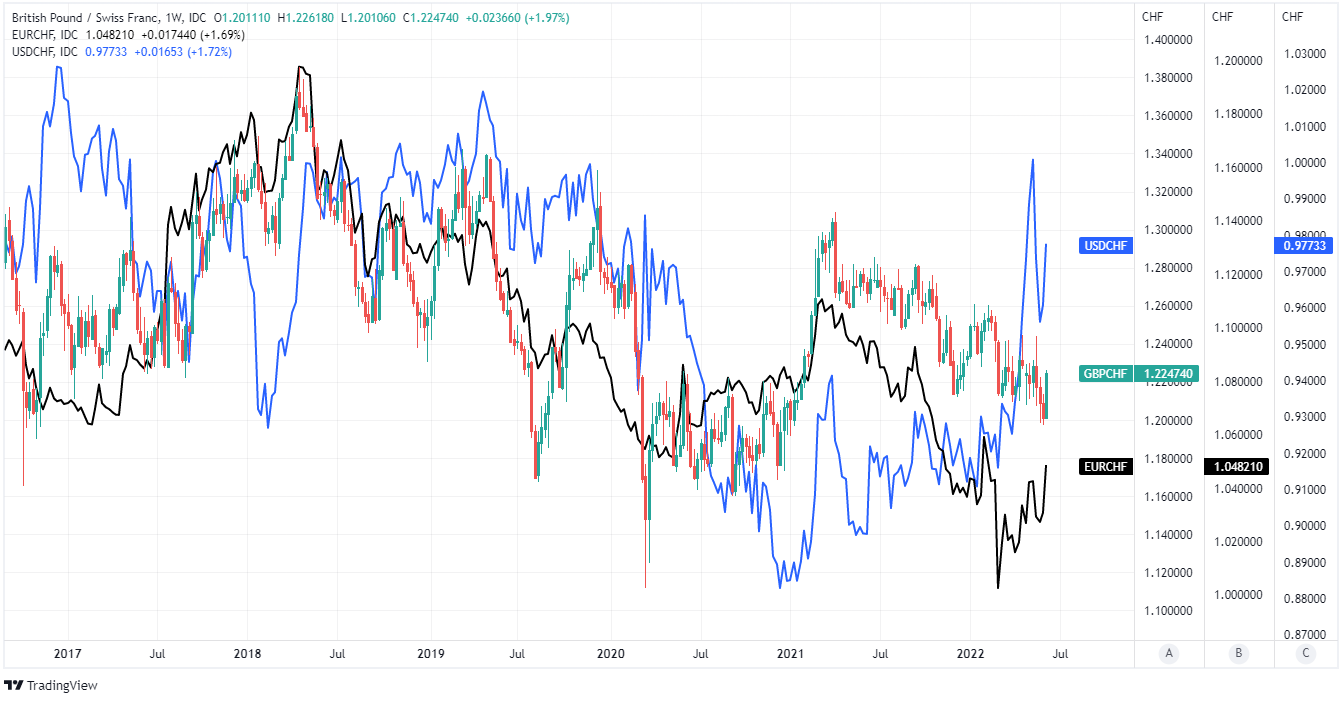Swiss Franc at Medium-term Risk from Devil in Detail of SNB Policy Challenge
- Written by: James Skinner
-
“If anything, though, the balance of risks is skewed towards the SNB living with a wider interest rate differential and potentially using the depreciation of the franc that would ensue as cover to start to sell some of its mountain of FX-denominated assets,” - David Oxley, Capital Economics.

Image © SNB
Switzerland’s Franc has climbed from 2022 lows beneath parity against the Dollar thanks to an optimistic take from the market on the outlook for Swiss National Bank monetary policy, although one economist has warned that the SNB could yet become a headwind for the Franc again in the year ahead.
The Swiss Franc weakened sharply on Wednesday as the Dollar and Euro rose almost across the board but it remained comfortably above the lows established in the middle of May when the U.S. currency was at its strongest.
Key to the intervening recovery has been statements from SNB policymakers that have led the market to expect that the bank will lift its interest rate for the first time since before the 2008 financial crisis during the months ahead, which has been a game-changer for how analysts view the Franc.
“The SNB’s recent comments confirm in our minds the primacy of its low inflation aim, and therefore suggest a sharp turn in their view towards currency appreciation. This is partly why we have recommended that investors go short GBP/CHF (targeting 1.18) on the prospect of SNB policy tightening,” says Michael Cahill, a G10 FX strategist at Goldman Sachs, in a May 25 briefing.
"While our economists still expect the SNB to wait until September, we think the Lagarde blog post further improves the risk-reward of paying the June meeting at around 8-10bps above current overnight rights. The SNB only has four meetings per year, which should require greater premium given the level of data volatility, and we think the market is still under-appreciating the policy change underway in Switzerland," Cahill and colleagues also wrote.
 Above: Blue line shows expectations for SNB cash rate in years ahead as implied by forward-rate-agreements on June 06. Green and other lines show the same measure of implied expectations on various other dates. Source: Goldman Sachs Marquee. Click image for closer inspection.
Above: Blue line shows expectations for SNB cash rate in years ahead as implied by forward-rate-agreements on June 06. Green and other lines show the same measure of implied expectations on various other dates. Source: Goldman Sachs Marquee. Click image for closer inspection.
Switzerland’s inflation rate rose to 2.9% in May and its core inflation rate reached 1.7%, indicating that even after changes in internationally traded energy and food prices are overlooked, Swiss inflation is fast approaching the upper limit of the SNB’s target and tolerance band.
This is a big part of why SNB policymakers including Chairman of the Governing Board Thomas Jordan have reportedly said in recent weeks that they would respond with changes to Swiss interest rates if these price pressures persist for any meaningful length of time.
However, the now widely anticipated increase in European Central Bank interest rates this summer may also be a motivator of the SNB too and in part because without similar action in Switzerland, it could weaken the currency and add to Swiss inflation pressures.
“It is not optimal for a central bank to hold rates deep in negative territory for a prolonged period and higher rates from the ECB may give the SNB an opportunity to start correcting this position,” says Jane Foley, head of FX strategy at Rabobank.
“Under the cover of ECB rate hikes, the SNB may be able to execute a little bout of policy tightening of its own to pull its key rate back towards zero without creating too many waves for the EUR/CHF exchange rate,” Foley wrote in a late May research briefing.
 Above: Pound to Franc rate shown at daily intervals alongside USD/CHF and EUR/CHF. Click image for closer inspection.
Above: Pound to Franc rate shown at daily intervals alongside USD/CHF and EUR/CHF. Click image for closer inspection.
All of the above has contributed to financial markets’ abrupt shift during recent weeks to quickly pricing-in a series of interest rate changes in Switzerland for later this year, and this explains why a large part of the market has abandoned earlier bearish views on the Franc.
The widely held suspicion is that for reasons related to inflation, the SNB is no longer inclined to counter strength in the Franc and is instead likely to embrace it, although one economist has warned that its preference could soon shift again and in the direction of a desire for weakness in the currency.
This has a lot to do with the challenges posed by the SNB’s balance sheet, which has ballooned since the years after the Eurozone debt crisis when the bank began to use intervention in order to fend off unwarranted currency strength and is something the SNB is thought to be uncomfortable with.
“We forecast the SNB to largely shadow ECB rate hikes over the next 18 months or so, albeit allowing the interest rate differential with the euro-zone to widen from 25bps at present to 50bps by end-2022,” says David Oxley, a senior Europe economist at Capital Economics.
“If anything, though, the balance of risks is skewed towards the SNB living with a wider interest rate differential and potentially using the depreciation of the franc that would ensue as cover to start to sell some of its mountain of FX-denominated assets,” Oxley told clients on Tuesday this week.
 Above: Pound to Franc rate shown at weekly intervals alongside USD/CHF and EUR/CHF. Click image for closer inspection.
Above: Pound to Franc rate shown at weekly intervals alongside USD/CHF and EUR/CHF. Click image for closer inspection.







